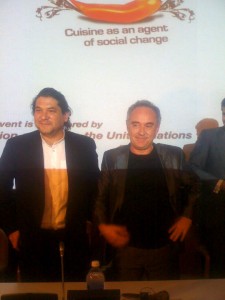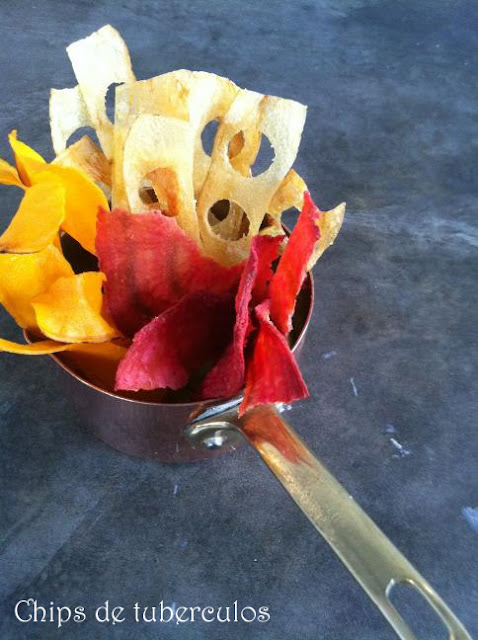Desde Nueva York, Javier Ansorena entrevista al chef español, que presentó la semana pasada conGastón Acurio el documental ‘Perú Sabe’.
 Ferran Adrià pasó hace una semana por Nueva York para presentar, junto al chef peruano Gastón Acurio, el documental ‘Perú Sabe’. No es un proyecto cualquiera. El lunes 11 de junio, cuando se presentó la película en el cuartel general de Naciones Unidos, el cocinero catalán aseguró que era “el día más importante de su vida”.
Ferran Adrià pasó hace una semana por Nueva York para presentar, junto al chef peruano Gastón Acurio, el documental ‘Perú Sabe’. No es un proyecto cualquiera. El lunes 11 de junio, cuando se presentó la película en el cuartel general de Naciones Unidos, el cocinero catalán aseguró que era “el día más importante de su vida”.
La cocina peruana no sólo es una gastronomía que está ‘de moda’ en todo el mundo. ‘Perú Sabe’ muestra en un recorrido por decenas de lugares y personas peruanos vinculados a la cocina cómo la gastronomía se ha convertido en un transformador social y económico de un país. Y esa realidad es un caramelo demasiado apetitoso para alguien como Adrià, empeñado en llevar a la cocina a un lugar central de la sociedad a través de la innovación.
La entrevista tiene lugar en la sucursal neoyorquina de La Mar, la célebre cebichería de su compañero de fatigas Gastón Acurio. El restaurante está en frente de Madison Square Park, una de las zonas privilegiadas de la Gran Manzana, y donde la gastronomía está ganando enteros: locales como 11 Madison, Eataly, Grammercy Tavern, el restaurante del hotel NoMad o la hamburguesería Burger Shack están a tiro de piedra.
“En tres o cuatro años veremos la expansión internacional
de las tapas contemporáneas”
Adrià protesta porque apenas le da tiempo a probar nada cada vez que viene: “Todo, me interesa todo. Japonés, locales de Chinatown, cebiche como el que se encuentra aquí. Lo malo de Nueva York es que hay demasiado… Entonces, o te llevan, o vas perdido”.
Donde no se pierde es a la hora de explicar la importancia de ‘Perú Sabe’, de la expansión internacional de la cocina española o de su gran proyecto personal, elBullifoundation. Llega con la mirada encendida y con ganas de hablar de Perú y su gastronomía.
¿Por qué te has embarcado en el proyecto
de ‘Perú Sabe’ con tanto empeño?
Creo que este documental es una herramienta para marcar un antes y un después en la relación de la sociedad con la cocina. Desde mediados de los años 70, la cocina empezó a dialogar con la sociedad, a través de su presencia en programas de televisión, o en ámbitos como la sostenibilidad, la ecología… Esto ha llegado a un tanto por ciento de la sociedad, quizá entre el 10% y el 15%, fundamentalmente en las capas sociales media-altas. ¿Qué es lo que ha pasado en Perú? Que esta penetración ha llegado a un 80% de la sociedad, y esa es la gran revolución.
¿Y por qué ha ocurrido un fenómeno así precisamente en Perú?
Eso es lo que intenta explicar el documental, reflejar ese paso adelante. Se explica a través de multitud de historias de lugares y gentes. No es un documental sobre cocina y tampoco cae en el populismo. Al contrario, es muy pragmático, y muestra sobre todo cómo la cocina puede ser un arma para el desarrollo socioeconómico de un país.
Al fin y al cabo, la cocina es espíritu emprendedor e innovación,
y eso equivale a desarrollo…
Sí, y una de las cosas que me dan envida sana sobre Perú es que es el único país en el mundo que yo conozco en el que el debate sobre tradición y modernidad no existe y se acepta la innovación en cualquier tipo de cocina. Y la no innovación también se acepta. Pero se pierde tanta energía y tiempo con estos debates… Y esto en Perú no pasa porque se acepta que la gente busque su mejor cebiche, que le dé un pequeño toque diferente, y eso es ADN de innovación. No estamos hablando de vanguardia, porque aún les falta para estar en ese lugar, pero el paso intermedio que están dando es increíble. Y uno de los retos que tiene Perú es mantener ese camino, porque conforme hay más éxito y reconocimientos, es más difícil de sostener.
“ElBullifoundation será un ‘escáner’ de proyectos
interesantes en todo el mundo”
Imagino que ese boom interior contribuye a la proyección
internacional de la cocina peruana…
Eso es una consecuencia. Pero lo realmente importante es el desarrollo socioeconómico que consigue y el mimetismo que provoca en otros países en desarrollo. En Chile me han preguntado: ‘¿Qué tenemos que hacer para tener esa notoriedad en el mundo de la cocina?’, y lo mismo en México y Brasil. Lo importante es que cada país tenga su estrategia, pero es muy positivo que tengan el ejemplo de Perú.
 ¿Cómo se está viviendo este fenómeno dentro de Perú?
¿Cómo se está viviendo este fenómeno dentro de Perú?
Para la gente que no conoce Perú se pueda hacer a la idea de qué es lo ocurre. Doy un ejemplo muy fácil: lo que significó para España ganar el Mundial de fútbol, eso es lo que representa la cocina en Perú. Ahora, están en la semifinal del Mundial, saben lo que pueden ganar, tienen autoestima y orgullo y se ha movilizado todo el país. Si no lo ves, no lo crees. Cuando llegas al aeropuerto de Lima y te sientas en un taxi, el 70% de los taxistas te va a hablar de comida, te va a preguntar si has comido cebiche, sitios donde comer… Los niños no quieren ser futbolistas o actores, quieren ser cocineros. Eso es bestial, cambia el panorama del país.
¿Cómo se compara el boom peruano con la situación
de la cocina española?
Gastón [Acurio] ha conseguido algo con sus restaurantes que nosotros no hemos sido capaces de hacer en 20 años. Las tapas españolas, o la cocina española como la entendemos, no se ha exportado como debía. La cocina española de vanguardia lo que exportó fue el concepto de innovación y creatividad, algo que llegó a Italia, a EEUU, a Dinamarca o a Perú. La referencia ahí es España. Lo que pasa es que estamos en un momento de reordenar todo lo que ha pasado. Tenemos que ser objetivos y realistas y ser conscientes de lo que hemos hecho. En España, todavía se duda y se dice ‘no es para tanto’, mientras que aquí, por ejemplo, en EEUU, en Silicon Valley, tienen aelBulli como referencia en el mundo empresarial y tecnológico. Hace falta pragmatismo y realismo para ordenar esto. Y veremos en tres, cuatro o cinco años la expansión de las tapas españolas contemporáneas. Es que hasta hace dos o tres años no existían Lamoraga o Tickets. Esta adaptación del producto español en el mundo es lo que estamos haciendo poco a poco, como los japoneses hicieron con el sushi.
“En España todavía se duda de elBulli, mientras que en EEUU
es una referencia para el mundo empresarial y tecnológico”
Ahora que estamos en Nueva York, ¿qué te interesa de la gastronomía
de EEUU, de sus modelos de negocio?
Las ganas de hacer cosas. La capacidad de conceptualizar productos de restauración. La organización, yo aprendí mucho en EEUU. Antes, no hacíamos reuniones de equipo en elBulli, y lo aprendimos aquí. Y también es un país en el que pasan muchas cosas desde el punto de vista gastronómico, y al que yo personalmente quiero mucho porque me quieren mucho. Hay un feeling. Estaba antes discutiendo con amigos el porqué de la pasión aquí por elBulli, por mi trabajo… Y lo que decían es que se valora mucho el ‘challenge’, el desafío, el reto de transformar elBullifoundation. Aunque no entiendan muy bien en qué se va a convertir, ellos no dudan.
Ése es tu gran proyecto personal. ¿Cómo ha sido la experiencia
del concurso de ideas sobre la fundación con cinco de las principales
escuelas de negocios del mundo?
Fantástica. Ha habido 31 equipos de centros de primer nivel [el ganador se conocerá el próximo 27 de junio] que te permiten tener un feedback impresionante sobre qué estamos haciendo bien, qué se puede mejorar, qué ideas podemos aportar…
“En EEUU se valora mucho el desafío que supone
transformar elBullifoundation”
ElBullifoundation todavía no es un proyecto definido,
pero, ¿qué dirección va a tomar?
Uno de los trabajos más importantes de elBullifoundation se centrará en ser un escáner de proyectos interesantes de la cocina en todo el mundo. Nosotros somos un I+D pequeño, y vamos a ver qué está pasando en la escena internacional, analizarlo y compartirlo a través de Internet.
¿Algún otro proyecto de futuro en EEUU?
Estoy en conversaciones para que vengan dos exposiciones a Nueva York, en 2013 y 2014. Una es la que está ahora mismo en el Palau Robert de Barcelona, que va a venir al Museo de Historia Natural. Y la otra será en otro museo de la ciudad, pequeño pero muy importante… Ya lo veréis.
Tomado de Gastroeconomy:




















